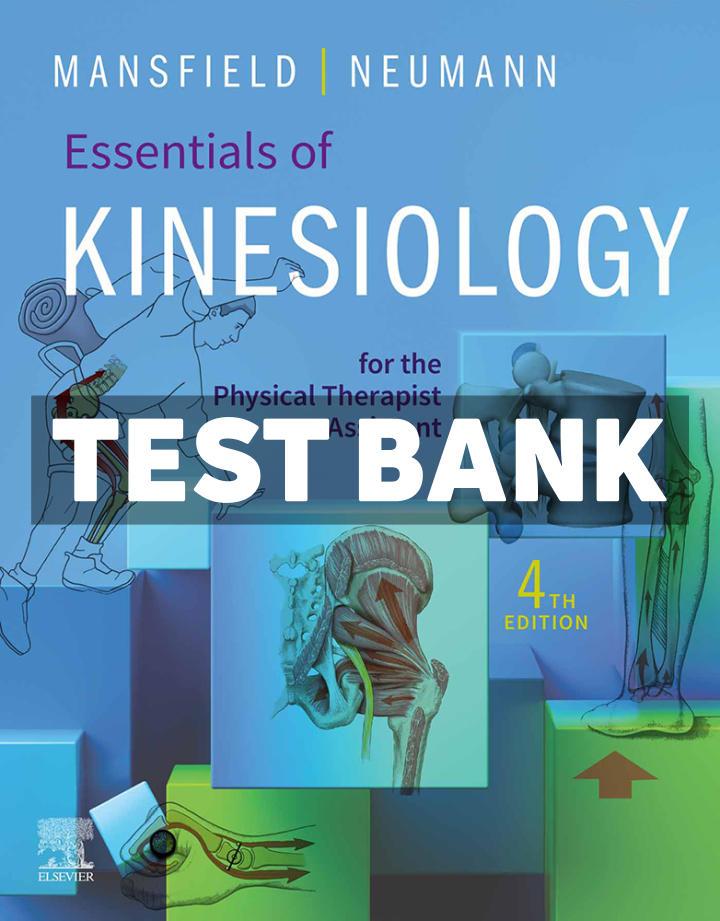

Test Bank - Chapter 01
Q: Translation occurs when:
A. All parts of a body move in the same direction as every other part (Correct)
B. All parts of a body move in opposite directions
C. A body moves around an axis of rotation
D. The center of mass is constant
Q: If a clinician provided the force necessary to move a person’s limb through the ranges of motion, this movement would demonstrate:
A. Active movements
B. Gravitational range of motion
C. Simulated movements
D. Passive range of motion (Correct)
Q: The motion of bones relative to the three cardinal planes of the body is known as:
A. Transverse adjustment
B. Anatomic positioning
C. Osteokinematics (Correct)
D. Pivot point rot
Q: _____ describes a circular motion through two planes.
A. Adduction
B. Circumduction (Correct)
C. Flexion
D. Extension
Q: When multiple points along one rotating articular surface contact multiple points on another articular surface, this is known as a:
A. Roll (Correct)
B. Slide
C. Spin
D. Lever
Q: Rotation describes:
A. The arc of movement of a body about an axis (Correct)
B. Movements generated by an active muscle
C. Movements generated by non-muscular activation such as gravity
D. Motion of the sagittal plane
Q: The plane dividing the body into right and left halves is the:
A. Frontal plane
B. Horizontal plane
C. Sagittal plane (Correct)
D. Transverse plane
Q: _____ are used in kinesiology to represent the magnitude and direction of a force.
A. Axes of rotation
B. Vectors (Correct)
C. Levers
D. External torques
Q: The moment arm is defined as:
A. Tension generated from ligamentous elongation
B. The arthrokinematic spin occurring in the shoulder
C. Motion occurring between the articular surfaces of joints
D. The length between the axis of rotation and the perpendicular intersection of the force (Correct)
Q: The amount of _____ generated across a joint depends on the amount of force exerted and the distance between the force and the axis of rotation.
A. Torque (Correct)
B. Lever strength
C. Slide
D. Closed-chain motion
Q: Movement of the distal segment of bone about a relatively fixed proximal segment is often referred to as a(n) _____.
A. Closed-chain motion
B. Arthrokinematic loop
C. Open-chain motion (Correct)
D. Convex articulation
Q: Movement of the proximal segment of bone about a relatively fixed—or stationary—distal segment is referred to as a(n) _____.
A. Closed-chain motion (Correct)
B. Arthrokinematic loop
C. Open-chain motion
D. Convex articulation
Q: The motion of a top moving in one spot on the floor would best be described as _____
A. Roll
B. Spin (Correct)
C. Slide
D. Drop
Q: Both passive and active forces generated from within the body are known as _____
A. External forces
B. Intrinsic movements
C. Extrinsic movements
D. Internal forces (Correct)
Q: The origins of the word kinesiology are from the Greek kinesis, “to move,” and ology, “to study.”
A. True (Correct)
B. False
Q: Kinematics is a branch of biomechanics that deals only with the effects of torque on the body.
A. True
B. False (Correct)
Q: The sagittal plane divides the body into left and right halves.
A. True (Correct)
B. False
Q: The frontal plane divides the body into upper and lower sections.
A. True
B. False (Correct)
Q: Degrees of freedom refers to the number of planes of motion allowed at a joint.
A. True (Correct)
B. False
Q: Abduction describes movement of a body segment in the frontal plane, toward the midline.
A. True
B. False (Correct)
Q: Protraction describes the translation of a bone away from the midline in a plane parallel to the ground.
A. True (Correct)
B. False
